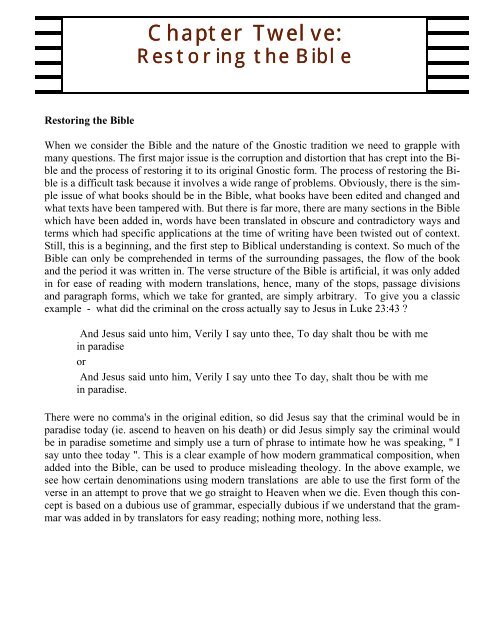gnostic handbook
gnostic handbook
gnostic handbook
You also want an ePaper? Increase the reach of your titles
YUMPU automatically turns print PDFs into web optimized ePapers that Google loves.
Chapter Twelve:<br />
Restoring the Bible<br />
Restoring the Bible<br />
When we consider the Bible and the nature of the Gnostic tradition we need to grapple with<br />
many questions. The first major issue is the corruption and distortion that has crept into the Bible<br />
and the process of restoring it to its original Gnostic form. The process of restoring the Bible<br />
is a difficult task because it involves a wide range of problems. Obviously, there is the simple<br />
issue of what books should be in the Bible, what books have been edited and changed and<br />
what texts have been tampered with. But there is far more, there are many sections in the Bible<br />
which have been added in, words have been translated in obscure and contradictory ways and<br />
terms which had specific applications at the time of writing have been twisted out of context.<br />
Still, this is a beginning, and the first step to Biblical understanding is context. So much of the<br />
Bible can only be comprehended in terms of the surrounding passages, the flow of the book<br />
and the period it was written in. The verse structure of the Bible is artificial, it was only added<br />
in for ease of reading with modern translations, hence, many of the stops, passage divisions<br />
and paragraph forms, which we take for granted, are simply arbitrary. To give you a classic<br />
example - what did the criminal on the cross actually say to Jesus in Luke 23:43 <br />
And Jesus said unto him, Verily I say unto thee, To day shalt thou be with me<br />
in paradise<br />
or<br />
And Jesus said unto him, Verily I say unto thee To day, shalt thou be with me<br />
in paradise.<br />
There were no comma's in the original edition, so did Jesus say that the criminal would be in<br />
paradise today (ie. ascend to heaven on his death) or did Jesus simply say the criminal would<br />
be in paradise sometime and simply use a turn of phrase to intimate how he was speaking, " I<br />
say unto thee today ". This is a clear example of how modern grammatical composition, when<br />
added into the Bible, can be used to produce misleading theology. In the above example, we<br />
see how certain denominations using modern translations are able to use the first form of the<br />
verse in an attempt to prove that we go straight to Heaven when we die. Even though this concept<br />
is based on a dubious use of grammar, especially dubious if we understand that the grammar<br />
was added in by translators for easy reading; nothing more, nothing less.


